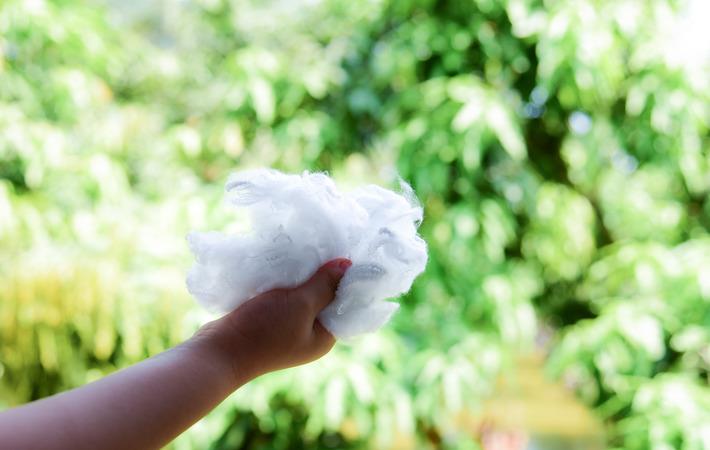The global trade of artificial staple fibres (carded, combed or otherwise processed for spinning) of have shown a slight drop in 2019 after considerable rise in 2018. Total trade increased 4.76 per cent from $55.36 million in 2017 to $57.99 million in 2019, according to data from TexPro. The total trade declined 3.79 per cent in 2019 over the previous year.
The global trade of artificial staple fibres (carded, combed or otherwise processed for spinning) of have shown a slight drop in 2019 after considerable rise in 2018. Total trade increased 4.76 per cent from $55.36 million in 2017 to $57.99 million in 2019, according to data from TexPro. The total trade declined 3.79 per cent in 2019 over the previous year.#
The global trade of artificial staple fibres (carded, combed or otherwise processed for spinning) of have shown a slight drop in 2019 after considerable rise in 2018. Total trade increased 4.76 per cent from $55.36 million in 2017 to $57.99 million in 2019, according to data from TexPro. The total trade declined 3.79 per cent in 2019 over the previous year.#
The global export of artificial staple fibres was $29.21 million in 2017, which grew 5.62 per cent to $30.85 million in 2019. Total exports fell 6.69 per cent in 2019 over the previous year and is expected to move up to $33.49 million in 2022 with a rate of 8.55 per cent from 2019.
The global trade of artificial staple fibres (carded, combed or otherwise processed for spinning) of have shown a slight drop in 2019 after considerable rise in 2018. Total trade increased 4.76 per cent from $55.36 million in 2017 to $57.99 million in 2019, according to data from TexPro. The total trade declined 3.79 per cent in 2019 over the previous year.#
The global import value of artificial staple fibres was $26.15 million in 2017, which increased 3.79 per cent to $27.14 million in 2019. Total imports decreased 0.27 per cent in 2019 over the previous year and is expected to rise to $28.70 million in 2022 with a rate of 5.75 per cent from 2019.
The global trade of artificial staple fibres (carded, combed or otherwise processed for spinning) of have shown a slight drop in 2019 after considerable rise in 2018. Total trade increased 4.76 per cent from $55.36 million in 2017 to $57.99 million in 2019, according to data from TexPro. The total trade declined 3.79 per cent in 2019 over the previous year.#
China ($8.86 million), Austria ($6.20 million), Germany ($6.11 million) and Italy ($2.80 million) were the key exporters of artificial staple fibres across the globe in 2019, together comprising 77.70 per cent of total export. These were followed by Turkey ($1.64 million), Spain ($1.55 million) and US ($0.77 million).
The global trade of artificial staple fibres (carded, combed or otherwise processed for spinning) of have shown a slight drop in 2019 after considerable rise in 2018. Total trade increased 4.76 per cent from $55.36 million in 2017 to $57.99 million in 2019, according to data from TexPro. The total trade declined 3.79 per cent in 2019 over the previous year.#
From 2016 to 2019, the most notable rate of growth in terms of export value, amongst the main exporting countries, was attained by Austria (136.35 per cent) and China (9.38 per cent).
The global trade of artificial staple fibres (carded, combed or otherwise processed for spinning) of have shown a slight drop in 2019 after considerable rise in 2018. Total trade increased 4.76 per cent from $55.36 million in 2017 to $57.99 million in 2019, according to data from TexPro. The total trade declined 3.79 per cent in 2019 over the previous year.#
Italy ($4.77 million), Belgium ($4.10 million), China ($2.78 million) and Czech Republic ($2.15 million) were the key importers of artificial staple fibres across the globe in 2019, together comprising 50.84 per cent of total import. These were followed by Honduras ($1.88 million), Portugal ($1.46 million) and Bulgaria ($1.28 million).
The global trade of artificial staple fibres (carded, combed or otherwise processed for spinning) of have shown a slight drop in 2019 after considerable rise in 2018. Total trade increased 4.76 per cent from $55.36 million in 2017 to $57.99 million in 2019, according to data from TexPro. The total trade declined 3.79 per cent in 2019 over the previous year.#
From 2016 to 2019, the most notable rate of growth in terms of import value, amongst the main importing countries, was attained by the China (204.57 per cent), Czech Republic (176.35 per cent) and Belgium (90.14 per cent).
ALCHEMPro News Desk (JL)
